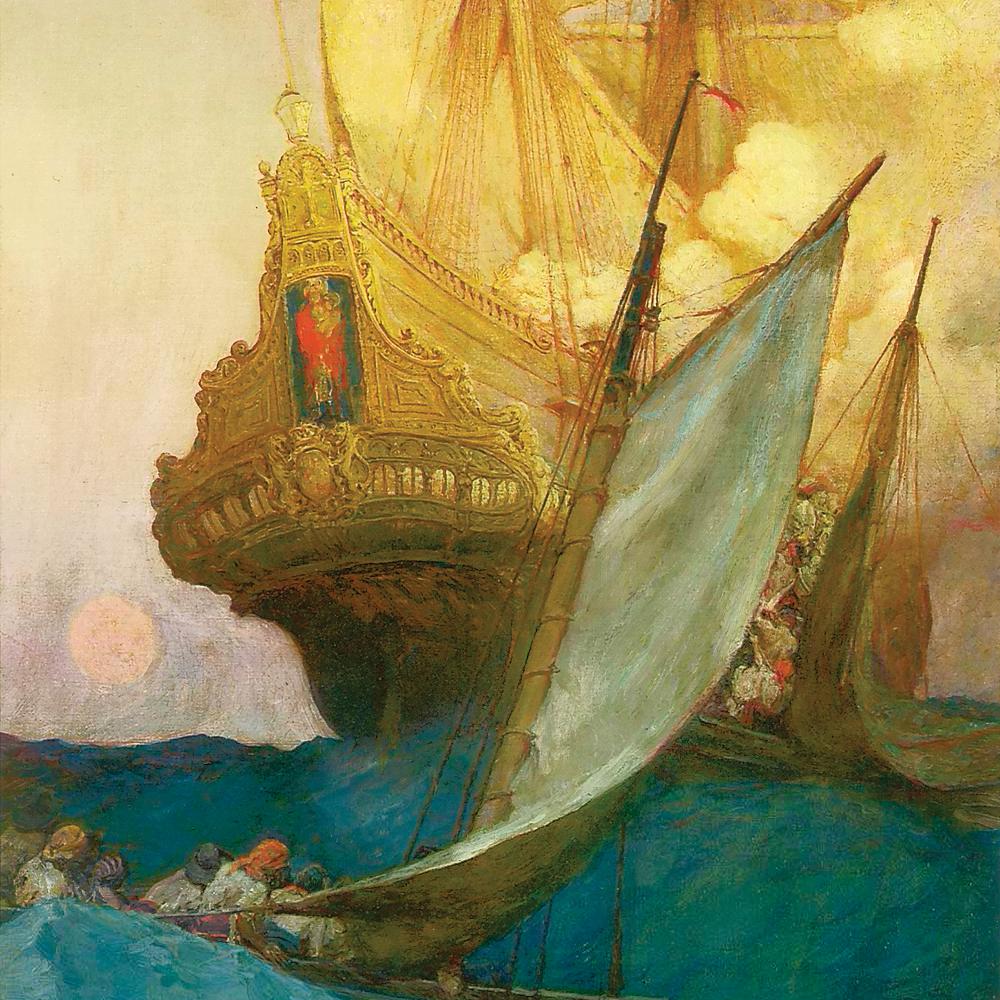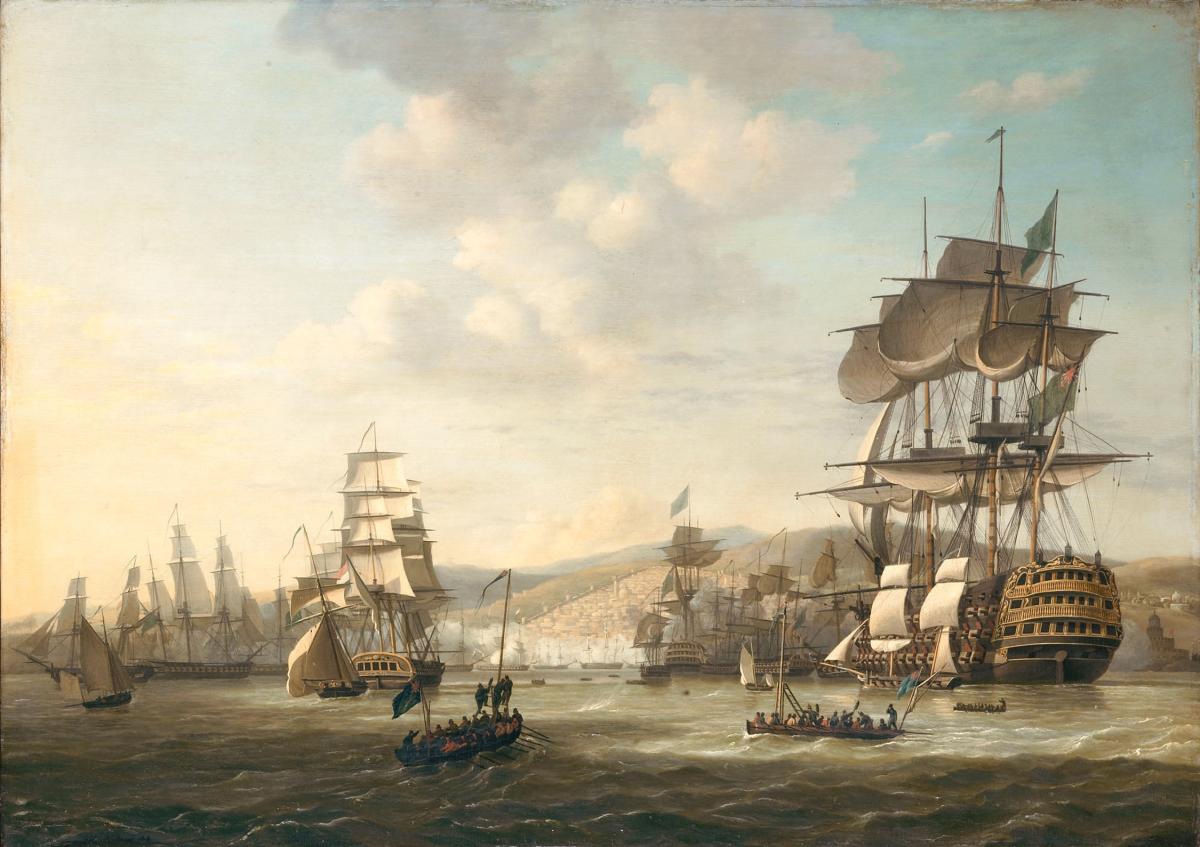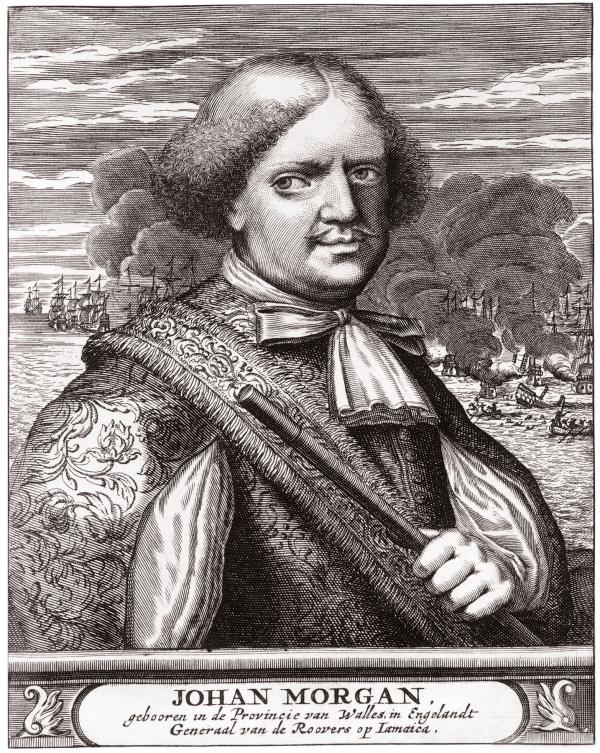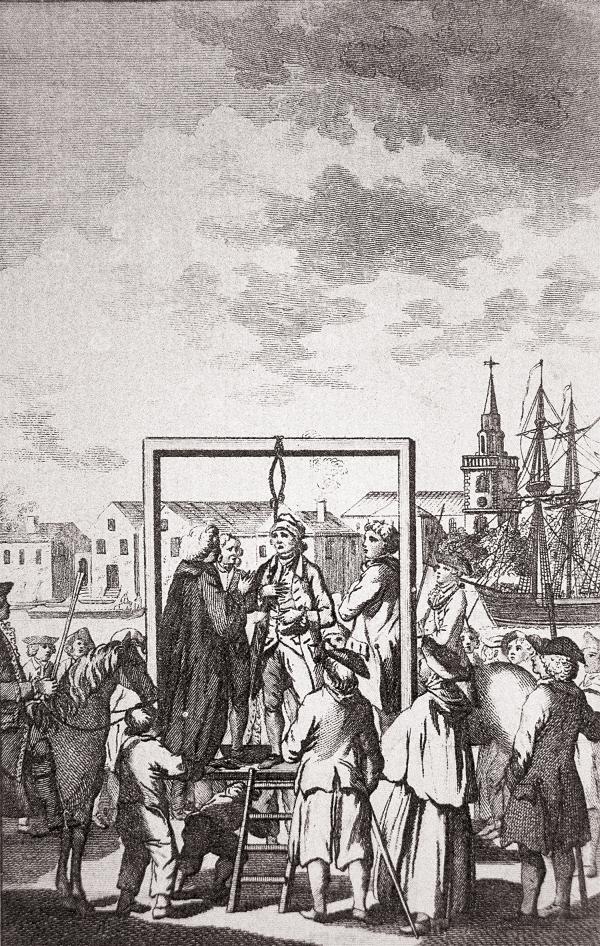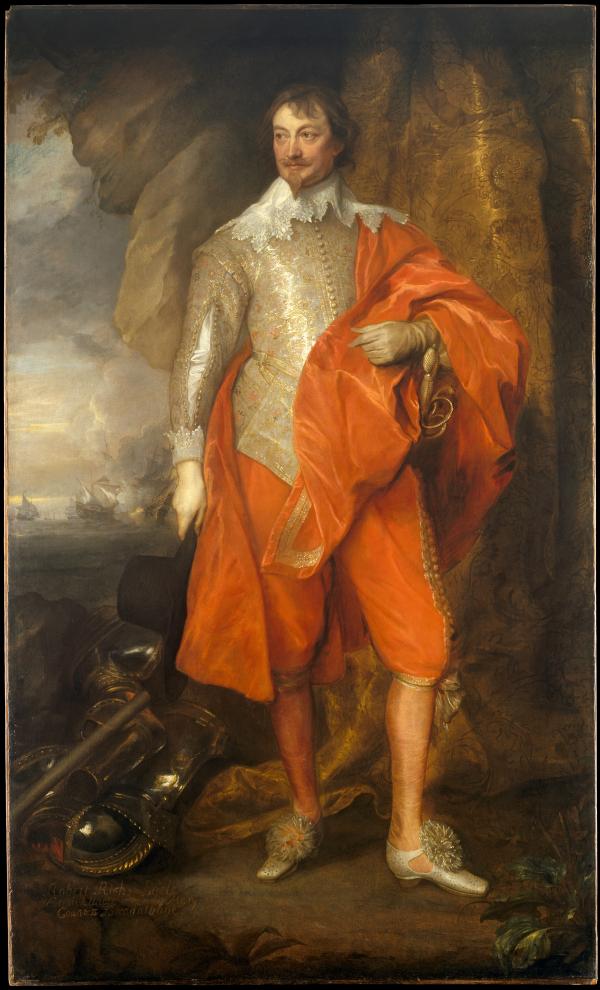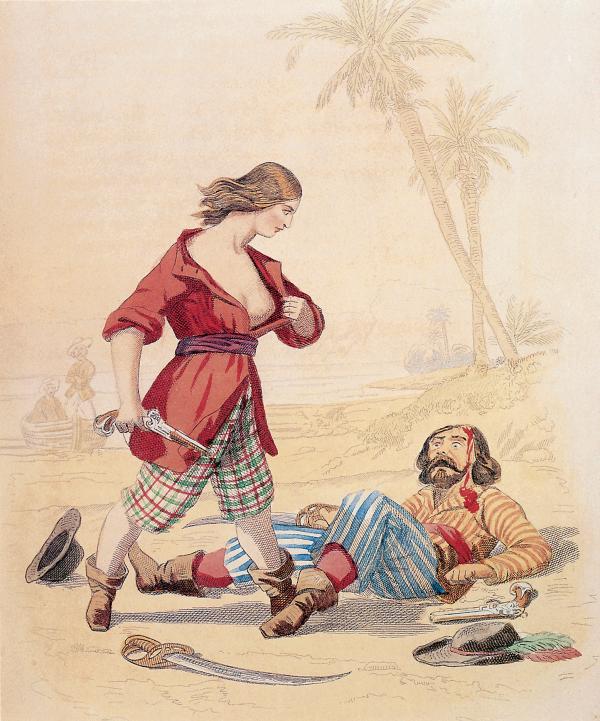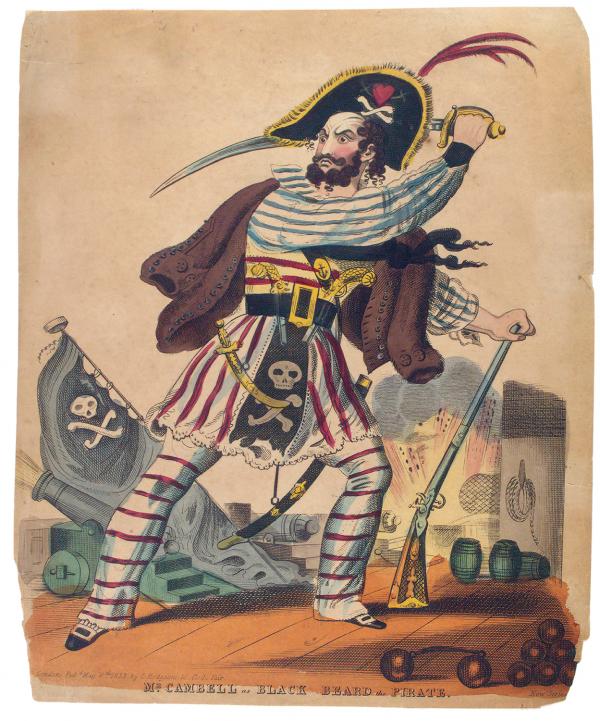In 1701, in Middletown, New Jersey, Moses Butterworth languished in a jail, accused of piracy. Like many young men based in England or her colonies, he had joined a crew that sailed the Indian Ocean intent on plundering ships of the Muslim Mughal Empire. Throughout the 1690s, these pirates marauded vessels laden with gold, jewels, silk, and calico on pilgrimage toward Mecca. After achieving great success, many of these men sailed back into the Atlantic via Madagascar to the North American seaboard, where they quietly disembarked in Charleston, Philadelphia, New Jersey, New York City, Newport, and Boston, and made themselves at home.
When Butterworth was captured, he admitted to authorities that he had served under the notorious Captain William Kidd, arriving with him in Boston before making his way to New Jersey. This would seem quite damning. Governor Andrew Hamilton and his entourage rushed to Monmouth County Court to quickly try Butterworth for his crimes. But the swashbuckling Butterworth was not without supporters.
In a surprising turn of events, Samuel Willet, a local leader, sent a drummer, Thomas Johnson, to sound the alarm and gather a company of men armed with guns and clubs to attack the courthouse. One report estimated the crowd at over a hundred furious East Jersey residents. The shouts of the men, along with the “Drum beating,” made it impossible to examine Butterworth and ask him about his financial and social relationships with the local Monmouth gentry.
Armed with clubs, locals Benjamin and Richard Borden freed Butterworth from the colonial authorities. “Commanding ye Kings peace to be keept,” the judge and sheriff drew their swords and injured both Bordens in the scuffle. Soon, however, the judge and sheriff were beaten back by the crowd, which succeeded in taking Butterworth away. The mob then seized Hamilton, his followers, and the sheriff, taking them prisoner in Butterworth’s place.
A witness claimed this was not a spontaneous uprising but “a Design for some Considerable time past,” as the ringleaders had kept “a pyratt in their houses and threatened any that will offer to seize him.”
Governor Hamilton had felt that his life was in danger. Had the Bordens been killed in the melee, he said, the mob would have murdered him. As it was, he was confined for four days until Butterworth was free and clear.
Jailbreaks and riots in support of alleged pirates were common throughout the British Empire during the late seventeenth century. Local political leaders openly protected men who committed acts of piracy against powers that were nominally allied or at peace with England. In large part, these leaders were protecting their own hides: Colonists wanted to prevent depositions proving that they had harbored pirates or purchased their goods. Some of the instigators were fathers-in-law of pirates.
There were less materialist reasons, too, why otherwise upstanding members of the community rebelled in support of sea marauders. Many colonists feared that crack-downs on piracy masked darker intentions to impose royal authority, set up admiralty courts without juries of one’s peers, or even force the establishment of the Anglican Church. Openly helping a pirate escape jail was also a way of protesting policies that interfered with the trade in bullion, slaves, and luxury items such as silk and calico from the Indian Ocean.
These repeated acts of rebellion against royal authorities in support of men who had committed blatant criminal acts inspired me to spend about ten years researching pirates, work that resulted in my book, Pirate Nests and the Rise of the British Empire, 1570–1740. In it, I analyzed the rise and fall of international piracy from the perspective of colonial hinterlands, from the inception of England’s burgeoning empire to its administrative consolidation. While traditionally depicted as swashbuckling adventurers on the high seas, pirates played a crucial role on land, contributing to the commercial development and economic infrastructure of port towns in colonial America.
Pirates could be found in nearly every Atlantic port city. But only particular locations became known as “pirate nests,” a pejorative term used by royalists and customs officials. Many of the most notorious pirates began their careers in these ports. Others established even deeper ties by settling in these cities and becoming respected members of the local elite. Instead of the snarling drunken fiends that parade through children’s books, these pirates spent their booty on pigs and chickens, hoping to live a more placid and financially secure life on land.
I was wholly uninterested in piracy as a child. I never dressed as a pirate on Halloween or even read pirate books. I went to graduate school at Harvard, intending to write about fatherhood in early America. In my third year, I presented to colleagues a 30-page essay that I hoped would be a chapter of my dissertation.
The paper was about William Harris, one of the first settlers of Rhode Island, who accumulated a massive estate through shrewd business tactics and slick legal dealings. A Puritan, Harris styled himself as an Abraham of the New World who would people a New Canaan. He composed a will that went to seven generations. In 1680, however, the elderly man was sailing toward London when Algerian pirates captured his vessel.
In the central market of the great walled city of Algiers, Harris was sold into slavery to a wealthy merchant. The once powerful man sent pitiful letters to Rhode Island, begging friends to ransom him and asking his wife to sell parts of his estate. He pleaded, “If you fail me of the said sum and said time it is most like to be the loss of my life, he [my captor] is so Cruel and Covetous. I live on bread and water.” After nearly two years of abject slavery, Harris became one of the lucky few to be ransomed. He made his way back to London, where, after a few weeks on Christian land, the exhausted patriarch died.
The Algiers episode was marginal to my larger points about fatherhood. But, as the discussion went around the room, all that anyone wanted to talk about was pirates. This was a few years before Pirates of the Caribbean: The Curse of the Black Pearl became a worldwide sensation. One colleague working on Atlantic families had noticed that locals in South Carolina seemed strangely unsurprised when pirates came ashore in the 1680s. Another colleague came upon a pirate who arrived in Newport in the 1690s, bought land, settled down, and became a customs official. This more-than-passing interest in pirates, as opposed to fathers, left me quite concerned. I had already taken my qualifying exams. I knew nothing about piracy. And since few scholars had written about piracy, I assumed it was not an important topic. Yet there it was, boarding the ship of my research agenda without permission.
Distraught, I cut a deal with my adviser that I would spend a month in the archives, examining government records and official correspondences to find out more. Sure enough, pirates were everywhere. But they were not who we thought they were. They were not anarchistic, antisocial maniacs. At least not in the seventeenth century. Like Moses Butterworth, many were welcome in colonial communities. They married local women, and bought land and livestock. Pirate James Brown even married the daughter of the governor of Pennsylvania and was appointed to the Pennsylvania House of Assembly.
Pirates, it seemed, could be civil, neighborly, and law-abiding. Why hadn’t this been noticed before? I chalk it up to specialization. By focusing so closely on their own areas of expertise, historians had overlooked how piracy permeated colonial life.
Piracy has not achieved its rightful place in the narrative of American history precisely because it was so familiar to the people of the English-speaking world of the seventeenth century. In the early days of the colonies, pirate attacks were considered a commonplace, inevitable feature of the maritime world, and noted only as entertaining asides. The prevalence of piracy in children’s stories and blockbuster movies has likely also made it difficult for historians to study the topic without romanticism. This was where my childhood disinterest in piracy paid off. I embarked on my research as a historian rather than as a fan.
Historians and fiction writers alike have portrayed pirates as inherently removed from civilized society. Hubert Deschamps in his 1949 Les pirates à Madagascar voiced what has become a standard trope: “[Pirates] were a unique race, born of the sea and of a brutal dream, a free people, detached from other human societies and from the future, without children and without old people, without homes and without cemeteries, without hope but not without audacity, a people for whom atrocity was a career choice and death a certitude of the day after tomorrow.” Seventeenth-century lawyers defined pirates, in the words of Admiralty judge Sir Leoline Jenkins, as hostis humani generis, or “Enemies not of one Nation or of one Sort of People only, but of all mankind.” Since pirates lacked the legal protection of any prince, nation, or body of law, “Every Body is commissioned and is to be armed against them, as against Rebels and Traytors, to subdue and root them out.”
Contemporary historians have tended to use pirates for their own ends, depicting them as rebels against convention. Their pirates critique early modern capitalism and challenge oppressive sexual norms. They are cast as proto-feminists or supporters of homosocial utopias. They challenge oppressive social hierarchies by flaunting social graces or wearing flamboyant clothing above their social stations. They subvert oppressive notions of race, citing the presence of black crew members as evidence of race blindness. Moses Butterworth, however, did none of these things.
The true rebels were leaders like Samuel Willet, establishment figures on land who led riots against crown authority. It was the higher reaches of colonial society, from governors to merchants, who supported global piracy, not some underclass or proto proletariat.
Popular culture has invested heavily in the image of pirates as anarchists who speak in colorful language and dress in attire recognizable to any five-year-old. In fact, what we imagine pirates to look and sound like matches only one decade of history: 1716 to 1726. Before that, piracy consisted of a spectrum of activities from the heroic to the maniacal. Many historians, like many pirate fans, write about piracy as a static phenomenon. This is the basis of popular events like International Talk Like a Pirate Day (September 19) or the costume worn by Jack Sparrow. When asked if these common tropes are true, I give a typical historian’s answer: It depends on when and where.
For the period before the 1713 Treaty of Utrecht, it makes more sense to talk about a sailor who commits piracy, rather than an actual “pirate.” Imagine a ten-year-old boy caught stealing candy from the store. If he learned his lesson, it would be ludicrous to call him a “thief” when he reached adulthood. If he goes on to get a PhD and becomes a respectable historian, it makes more sense to call him “professor.” Certainly there were flamboyant captains of legendary status who would never consider legitimate commerce as a way of life. But most sought one large prize and hoped to use their plunder to join the middling to upper echelons of colonial society.
One reason piracy was often an act or a phase, and not a way of life, was simply because humans have not evolved to live on the sea. The sea is a hostile place, offering few of the pleasures of terrestrial society. Pirates needed to clean and repair their ships, collect wood and water, gather crews, obtain paperwork, fence their goods, or obtain sexual gratification. Simply put, what is the value of silver and gold in the middle of the ocean? Why would someone risk his life in a hostile maritime world if there was no chance he could actually spend his booty?
“A Merry Life and a Short One” was not the motto of most pirates of the late seventeenth century. Until the 1710s, English pirates almost always had somewhere to go to spend their money, either for a few days or to settle down for good. The British National Archives holds a petition from 48 wives of known pirates, begging the crown to pardon their husbands so they could return home to care for their families. Returning to London was not an option for most sea rovers, but a life in the American colonies offered the closest proxy.
Support of piracy on the peripheries of the British Empire dates to the first forays of English sea captains overseas. Pirate Nests begins in Elizabethan England with the active protection of piracy by port communities in Devon and Cornwall. The ascension of James I coincided with the migration of a plunder economy from England to farther shores. Puritan communities in Ireland, and soon the fledgling colonies of Jamestown, Bermuda, New Plymouth, and Boston all supported illicit sea marauders. Upon the conquest of Jamaica in 1655, Port Royal became a renowned pirate nest, led by Henry Morgan, whose attacks against the Spanish were defended by the colony’s governor and council. By the 1680s, pirates who plundered along the Spanish Main or in the “South Sea” coasts of Chile and Peru dropped anchor in the North American colonies. In the 1690s, men like Moses Butterworth joined crews heading out of colonial ports to the Indian Ocean, basing themselves on the island of Madagascar.
Beginning in 1696, support for piracy was threatened by Parliament’s efforts to reform the legal and political administration of the colonies. Initial attempts to better regulate the colonies faced heated resistance like the riot that sprang Moses Butterworth in 1701. Royal officials battled with colonial elites over control of their court system, choice of governors, economic policies, and other issues. But the transformation of law, politics, economics, and even popular culture in a relatively brief period of time soon persuaded landed colonists of the long-term benefits of legal trade over the short-term boom of the pirate market. After being sprung from jail, Moses Butterworth eventually headed to Newport, where, in 1704, he captained a sloop that sailed alongside a man-of-war in pursuit of runaway English sailors. The former pirate had turned pirate-hunter.
The expansion of commercial trade, particularly the slave trade, cemented a colonial social order increasingly threatened by instability at sea and less tolerant of social mobility on land. This change in attitudes led to the period we call the “War on Pirates”—roughly 1716 to 1726—and the advent of sea marauders who, with little hope of ever resettling on land, attacked their own nation. This is the era of characters like Blackbeard (Edward Teach), Bartholomew Roberts, and female pirates Anne Bonny and Mary Read, colorful rebels who lived dangerously and fit the legend. Where for centuries pirates had sailed under the flags of their own nations or of foreign princes, they now sailed—and were hanged under—flags of their own construction. No longer welcomed by the colonial elite, outlaw vessels were routed from shores that once harbored pirate nests. In 1718 and 1723, the ports of Newport, Rhode Island, and Charleston, South Carolina, tried and hanged crews of 23 and 26 pirates, respectively, the two largest mass executions not involving a slave insurrection in colonial America. As a result, by the late 1720s the pirate scourge had largely abated.

